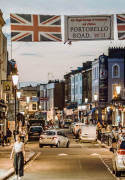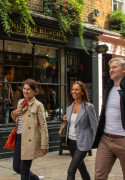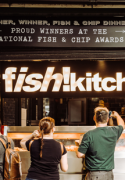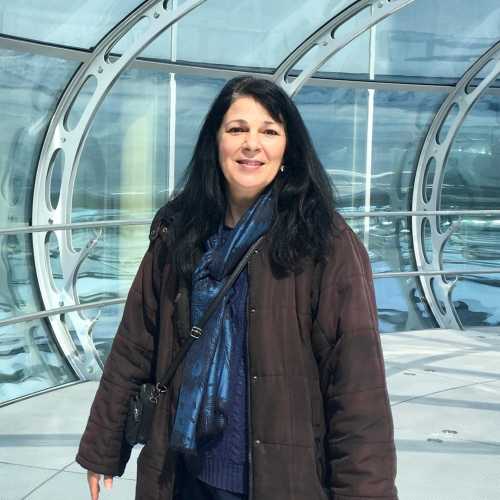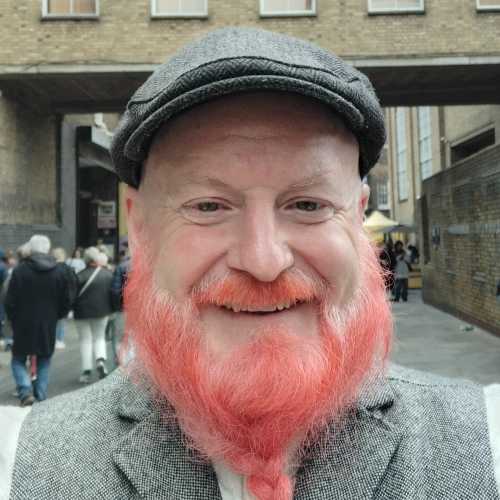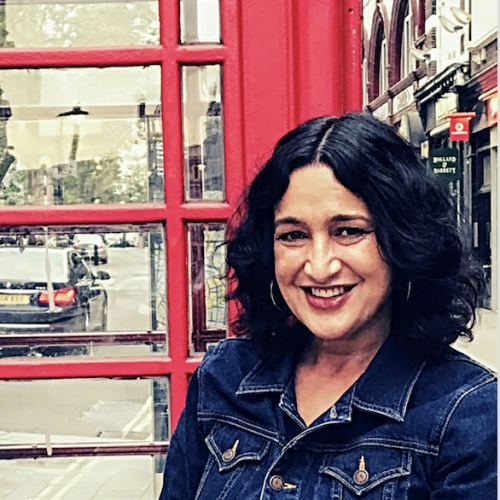See London’s Hidden Side on a Private Tour
Private tours, designed around you
Table Of Contents
- What Makes a Corner of London Feel Like a Hidden Gem?
- Where Do Londoners Spend Their Weekend Mornings?
- Which Cultural Spaces in London Still Feel Intimate?
- Where Do Londoners Go When They're Hungry and Not on a Tour?
- My Personal London Food and Drink Circuit
- Which Neighborhoods Show You London's Immigrant Heart?
- Where Can You Find Nature Without Leaving the City?
- What Are the Overrated
- How Do You Navigate London's Hidden Corners?
- Frequently Asked Questions About London's Hidden Gems
- Final Thoughts: What Hidden Gems in London Truly Mean

Canal bar & restaurant in Hackney
I've spent years listening to what Londoners call their own. These aren't hidden gems in the Instagram sense. They're just the corners that shape our weeks, the spots that rarely make it onto lists of things to do in London but probably should.
Some nights, I cycle from Hackney to a poetry reading, then stop at Mien Tay on Kingsland Road for late pho. Saturdays: coffee at E5 Bakehouse, Broadway Market, then Dulwich Picture Gallery, ending with West African food in Peckham. These aren't itinerary items. They're just life here, whether you're planning London experiences or settling into London long-term.

Nola Coffee in Peckham
What Makes a Corner of London Feel Like a Hidden Gem?
For me, a hidden gem is somewhere I'd genuinely choose on a Wednesday evening, not just take a visitor to prove I know the city.
Borough Market has incredible vendors, but most weeks I'd rather walk to Maltby Street Market on Saturday morning when stallholders remember I always ask for the ripest Montgomery cheddar. Brick Lane gets bagel tourists, but I'm at Carmelli in Golders Green where they know I want extra salt beef.
These choices are about quality of experience. The Churchill Arms looks beautiful covered in flowers, but I've never enjoyed a pint there. Too loud, too posed. I'd rather go to The Wenlock Arms in Hoxton. These distinctions shape how you experience London versus how you just pass through it, whether you're here long-term or planning a short London day trip from elsewhere.
Experiences Created by Locals, Just for You
See London through the eyes of the people who call it home.
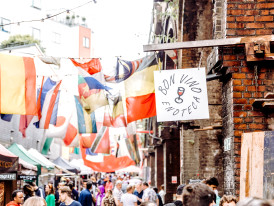
Maltby Street Weekend Market
Where Do Londoners Spend Their Weekend Mornings?
The way locals spend Saturday and Sunday mornings tells you more about a city than any tourist guide. Here's where we actually go when we have time to move slowly.
Ridley Road Market, Dalston
Every Saturday around 9 AM (when life allows), I'm at Ridley Road buying plantains from the same vendor who always throws in an extra yam. This market doesn't try to charm you. It's where Dalston really shops: West African, Caribbean, and Turkish families loading trolleys with okra, scotch bonnets, huge cuts of goat meat. This is east London at its most authentic, far from the polished markets of central London.
Vendors call out prices, someone's speaker plays old reggae, roasting corn mixes with fresh herbs. Last month I asked a woman selecting bitter leaf how she prepares it. She spent ten minutes teaching me her method. The market runs Tuesday through Saturday. Bring cash, bring bags, expect queues at good stalls.
Chatsworth Road on Sundays
This Hackney stretch becomes a neighborhood market every Sunday from 11 AM to 3 PM. Smaller than Broadway Market, slower-paced, full of makers who haven't been priced out yet. I buy sourdough from the same baker I've been getting it from for three years.

Busy Sunday street market on Chatsworth Road
Brockwell Park at Sunrise
Brockwell Park in south London earns the early alarm. The view from the hill at dawn, looking north over the city with mist caught in the trees, reminds me why I choose London.
The park offers options: walled garden for quiet sitting, ponds where herons fish, wide meadows. The lido opens year-round. Weekday mornings around 7 AM feel private in that shared way where everyone's giving everyone else space.

Brockwell Park
The Gun, Docklands
This riverside pub sits on the Thames in Docklands, far enough from central London that you're coming on purpose. I discovered it meeting a friend who works nearby. We sat outside watching the sun set behind Canary Wharf towers.
The food is gastropub standard, well-executed. The beer selection is better than most pubs I know. But really you're here for the terrace, the river, the feeling you've found something worth the journey. Summer evenings between 6 PM and 8 PM catch the best light.
Takeaway: Weekend mornings aren't about ticking off sights. They're about finding rhythms that match your pace.

Thames view from The Gun pub
Which Cultural Spaces in London Still Feel Intimate?
London has world-class museums, but some of the best art and performance experiences happen in smaller venues where you can actually breathe and think.
Access Note: Wilton's Music Hall and Sir John Soane's Museum have stairs and narrow passages. Dulwich Picture Gallery is more accessible with step-free ground floor access.

Wilton's Music Hall Entrance
Wilton's Music Hall
Wilton's hides down a narrow alley in Whitechapel. The building is the oldest surviving music hall in the world: crumbling Victorian grandeur, twisted iron columns, paint peeling in ways restoration would ruin.
I've seen folk bands here, experimental theater, spoken word nights. The acoustics are stunning. Last autumn I watched a singer perform with just guitar and voice, and you could hear every breath in the room. Book ahead because shows sell out.

Visitors at Sir John Soane's Museum
Which Cultural Spaces in London Still Feel Intimate?
Sir John Soane's Museum
Sir John Soane's former home in Holborn overwhelms me every time. Rooms stacked with sculptures, paintings, architectural fragments. The Picture Room has walls that open to reveal more paintings hidden behind paintings. The crypt holds ancient sarcophagi.
Entry is free but book a timed slot online. I come back every year because I always notice different details. Wednesday evenings they open late with candlelight tours, though I prefer morning visits.

Dulwich Picture Gallery
Dulwich Picture Gallery
This gallery in south London is what I wish all museums felt like: small, quiet, manageable. The building, designed by Sir John Soane, uses natural light beautifully.
The permanent collection includes Rembrandt, Canaletto, Gainsborough. I take the train to West Dulwich, walk through Dulwich Village which feels impossibly rural, then spend two hours in the gallery. The whole experience costs around £10.
Takeaway: London's best cultural experiences don't shout. These places trust you to notice rather than demanding your attention.
Where Do Londoners Go When They're Hungry and Not on a Tour?
The restaurants locals actually choose for their own meals tend to be smaller, cheaper, and located in residential neighborhoods most visitors never see.
Price Guide: Budget (£): Silk Road, Apollo Banana Leaf, E. Pellicci, Roti King, Golden Hind. Mid-range (££): P. Franco, Honey & Co., Lahore Kebab House.
Traditional British Done Right
E. Pellicci in Bethnal Green is where I go for a proper Full English breakfast. This family-run café has been here since 1900, and the Art Deco interior is protected by English Heritage. The breakfast is exactly what it should be: eggs cooked how you want them, proper bacon, good sausages, beans, toast, strong tea. Nothing fancy, everything perfect. Cash only.
Golden Hind in Marylebone does fish and chips the way it should be done. The fish comes in crispy batter that's not greasy, the chips are hand-cut, and they fry everything to order. It's been here since 1914, and they haven't changed what works. Sit down, order at the counter, enjoy fish that actually tastes like fish.
G. Kelly serves pie and mash, which is proper East End heritage food. If you've never had it, it's meat pie with mashed potato and a green parsley liquor sauce. It's an acquired taste, but it's authentic London working-class food that's been around since the 1800s. This isn't for everyone, but it's real.
Silk Road, Camberwell
I order the same thing every time: cumin lamb with hand-pulled noodles. The lamb comes crispy and aromatic, noodles have that perfect chew, and the whole plate costs less than a mediocre lunch in central London.
You sit at shared tables sometimes, portions are huge.

Chicken stew and hand-pulled noodles
Where Do Londoners Go When They're Hungry and Not on a Tour?
Silk Road serves Xinjiang food from northwest China. Small, family-run, zero pretension. You sit at shared tables sometimes, portions are huge. If you're exploring what to eat in London beyond the obvious, this rewards curiosity.
More Curry Beyond Apollo Banana Leaf
Apollo Banana Leaf, Tooting is where I go for hoppers: thin, crispy rice flour pancakes with soft centers, served with coconut sambal and curry. Tooting High Street is London's real curry capital, not Brick Lane.
I usually order too much. Egg hopper, string hoppers, kottu roti, whatever curry special they're running. Casual, loud, families eating together. If you're making the trip, walk the whole street: Indian sweets shops, Tamil grocers, Pakistani restaurants.

DEM Turkish Shish Grill in Crystal Palace
Lahore Kebab House and Tayyabs in Whitechapel are where you go for proper Pakistani food. Both are institutions. Tayyabs is famous for their lamb chops, which come sizzling and charred from the grill. Lahore Kebab House does exceptional karahi. Both are BYOB, both get packed, both are worth it. Expect to queue at peak times.
Roti King near Euston does Malaysian roti canai that people queue around the block for. The roti comes flaky and buttery, served with curry for dipping. It's fast, it's cheap, and it's one of those places where the queue tells you everything you need to know about the quality.
Caribbean and West African
Fish, Wings & Tings in Brixton is where I go for jerk chicken that actually has heat and flavor. Proper Caribbean food, not the watered-down tourist version. The jerk chicken comes with rice and peas, plantain, and enough spice to make you remember it. Small spot, big flavors.
805 in Peckham does West African food that's both traditional and creative. The jollof rice is excellent, the suya is properly spiced, and they do a rotating menu that showcases different West African cuisines. The space itself is small and always busy, which tells you everything.
East Asian Beyond the Obvious
Mien Tay on Kingsland Road is my Tuesday night spot for late pho. Vietnamese food done by Vietnamese people for Vietnamese customers, which means it's the real thing. The pho is rich and deep, the banh mi are excellent, and it's open late when you need something warming.
BaoziInn does Sichuan food that doesn't hold back on the numbing heat of Sichuan peppercorns. The dan dan noodles are exceptional, the dumplings are made fresh, and if you like spice, this delivers. There are a few locations now, but the original in Chinatown is still my favorite.
Song Que in Shoreditch is another Vietnamese spot that locals choose over flashier options. The pho is consistently good, the summer rolls are fresh, and the prices haven't gone up as much as everything else in Shoreditch.
Koya in Soho does udon noodles in a tiny space that fits maybe 20 people. You queue, you sit at the counter, you watch them make your noodles, you eat, you leave happy. It's simple and perfect. The cold udon in summer is particularly good.
Middle Eastern and Portuguese
Honey & Co. is a small Middle Eastern restaurant and deli in Fitzrovia run by an Israeli couple. The food is warm and bright: excellent hummus, grilled meats with herbs, salads that make vegetables exciting, desserts that taste like someone's grandmother made them. Book ahead because it's tiny.
Berber & Q does Middle Eastern and North African food with a grill focus. The meat is expertly cooked, the flavors are bold, and the space in Haggerston has a good energy. It's more mid-range pricing but worth it for a special meal.
Lisboa Patisserie on Golborne Road does Portuguese pastéis de nata that rival anything you'd get in Lisbon. The custard tarts are warm, flaky, perfectly sweet. Get there early because they sell out. It's also a proper Portuguese café, so the coffee is strong and the vibe is authentic.
DEM Crystal Palace is a family-run Turkish spot that does simple food really well. The meze is fresh, the grills come off the coals perfectly seasoned, and the portions are generous without feeling heavy. It’s relaxed, unfussy, and one of those neighbourhood places where the staff know half the guests by name.
Vegan Options That Actually Taste Good
Mildreds has been doing vegetarian and vegan food since before it was trendy. Multiple locations now, but the quality has stayed consistent. The menu changes seasonally, and they prove that vegan food doesn't need to apologize for being vegan.
Temple of Seitan does vegan fried "chicken" that's shockingly good. If you're skeptical about vegan substitutes, try their Nashville hot "chicken" sandwich and see if you can tell the difference. Multiple locations across London now.
P. Franco, Clapton
P. Franco is tiny, maybe 15 people fit, and they don't take bookings. You show up, hope for space. It's worth it for natural wines served by people who actually know what they're pouring.

P Franco Wine Bar in Clapton
No printed menu. They tell you what they have: wines by the glass that change weekly, small plates based on what's good. Last time they poured me something orange and funky I would never have ordered myself, and it was perfect with the aged cheese.
Takeaway: The best meals happen in neighborhoods you wouldn't visit otherwise. London's food scene runs deep: heritage British spots that have been here for over a century, curry houses serving diaspora communities, Caribbean jerk that doesn't compromise on spice, East Asian noodles made by people who grew up eating them, Middle Eastern flavors that transport you, Portuguese pastries worth crossing the city for, and vegan food that makes converts. These places feed locals who know the difference.
Hungry to Try London's Food Yourself?
Taste and explore the flavors locals actually love.

Whimsical interior of Vaulty Towers bar
My Personal London Food and Drink Circuit
Beyond the neighborhood spots I've already mentioned, I want to share the places I go when I have a bit more time or I'm meeting friends for a proper meal or evening out.
Markets Beyond the Food
London's market game is extremely strong, with many fun things to get up to. We've developed a real culture for stall shopping, thrifting, and seeking out needles in haystacks. East London has a flair for markets but really you can find them anywhere in London, and for any type of product you might be looking for, whether it be books, clothes, plants, artwork, or really just anything else.

Clothing stalls at Spitalfields Market
Spitalfields is great for vintage and hand-made clothes. I go there when I'm looking for something specific that I won't see on everyone else. Columbia Road Flower Market is great for the flowers, obviously, but also for the energy on Sunday mornings when the whole street smells like earth and stems and the vendors are calling out deals.
Food Markets Where Locals Eat
Speaking of markets, this is where the locals spend their weekends eating. I mean, I love a fancy restaurant in London (which I'll come to below), but often they're not that affordable and most people can't exactly dine out on London prices every weekend. Enter the food market revolution.
Ask locals and they'll tell you about how indoor dining markets like Tooting Broadway Market, Brixton Pop, BOXPARK, and Urban Food Fest are popping up all over London now, and it's supplemented by our delicious outdoor markets too, like Kings Cross Market, Kingston Market, Spitalfields, and Lower Marsh. Food in London can compete with some of the best in the world, and there is absolutely no fear of you going hungry here.

Buzzing Pop Brixton
Pop Brixton is a pioneering new space to support local start-ups, creative and community organizations in Brixton. It's a community initiative designed to drive progress and bring prosperity to local communities through enterprise. BOXPARK brings communities together by providing the best street food, drinks, and entertainment under one roof.
When I Want a Proper Sit-Down Meal
Chuku’s - Nigerian Tapas with London Soul
Neighborhood: Tottenham
Vibe: Colorful, creative, and full of energy
Why I love it: Chuku’s is the world’s first Nigerian tapas restaurant, run by a brother-and-sister duo who’ve turned small plates into a celebration of modern Nigerian culture. Think jollof quinoa, plantain waffles, and suya-spiced bites, all served with the best afrobeats soundtrack in London.
Local tip: It gets busy fast, especially on weekends. Book ahead and save room for the chin-chin cheesecake, it’s legendary.

Forty Dean Street in Soho
Amrutha - Vegan Soul Food That Feels Like Home
Neighborhood: Earlsfield
Vibe: Warm, community feel; bring-your-own-bottle
Why I love it: Amrutha has that rare mix of creativity and comfort. Their plant-based dishes are all made from scratch, and they somehow make simple ingredients taste extraordinary. It’s a neighborhood spot that’s earned big recognition, they even won Travellers’ Choice Best of the Best 2025.
Local tip: Bring your own wine (no corkage fees!) and come hungry, their sharing platters are the best way to taste everything.
Forty Dean Street - Soho’s Italian Comfort
Neighborhood: Soho
Vibe: Small, family-run, candle-lit
Why I love it: Forty Dean Street is one of those places that never tries too hard, and that’s why locals love it. The pasta is always fresh, the staff greet you like an old friend, and the tiramisu has real personality. From 5 PM they only seat guests 18+, so evenings are calm and grown-up.
Local tip: The set menu is brilliant value for central London, ideal before a show or after wandering Soho’s backstreets.
Fischer’s - A Taste of Old Vienna in Marylebone
Neighborhood: Marylebone High Street
Vibe: Elegant, nostalgic, with a steady hum of chatter
Why I love it: Fischer’s feels like stepping into Vienna a century ago, polished wood, waiters in waistcoats, and the smell of apple strudel in the air. They serve Central European dishes all day: schnitzel, goulash, and warm pretzels that taste like they came straight out of a Viennese café.
Local tip: Go for breakfast or late lunch when it’s quieter, and order the poppy seed cake with a glass of Austrian wine.
Curious What You Won’t Find Online About London's Drinks?
Discover the side only locals talk about.

Colorful indoor market at Seven Sisters Latin Village
Which Neighborhoods Show You London's Immigrant Heart?
London's diversity isn't theoretical. It's built into neighborhoods where immigrant communities have created their own infrastructure, their own markets, their own versions of home.
Access Note: Markets are curb-level and mostly accessible. Seven Sisters Latin Village is indoors. Queens Market and Green Lanes have level street access.
Seven Sisters Latin Village
Seven Sisters Indoor Market is Latin America in north London. Colombian arepas, Ecuadorian ceviche, Venezuelan cachapas, Brazilian pastries, hair salons playing reggaeton at volumes that make conversation difficult.
I come for arepas, usually cheese-filled, and always browse longer than planned. My Spanish is terrible but vendors are patient. This market has faced closure threats for years. It's still here, still serving the community that built it.
Queens Market, Upton Park
Queens Market in east London is one of the oldest and most diverse street markets. Runs six days a week. Vegetables for prices that make central London look absurd, fresh fish, halal meat, South Asian groceries, African fabrics.
Stallholders know their regulars by name. The produce is excellent and vendors will tell you how to cook things you've never seen before. Saturday mornings are busiest. Bring cash, bring bags.

Queens Market produce stalls with fruits and veg
Green Lanes Turkish Quarter
Green Lanes in north London smells like charcoal and cumin before you even see the restaurants. Ocakbaşı grills serving kebabs cooked over open flame, mezze spreads that cover your table, fresh flatbreads, strong tea.
I go to Gökyüzü when I want proper Turkish food. Last time with friends we ordered mixed grill for four, then added more lamb chops because they looked too good. Massive portions, fair prices, warmly chaotic atmosphere.
Walk the whole stretch. Turkish bakeries sell fresh simit and börek. Shops stock olive oils, spices, cheeses imported from Turkey. This is a neighborhood built by and for a community. For more on London's diverse food culture and hidden gems across different neighborhoods, these immigrant corridors offer the most authentic experiences.

Turkish food from Gokyuzu on the Green Lanes
Travel Guides Can Only Take You So Far
We connect travelers with locals who shape days that actually fit your interests, not someone else’s checklist.
See how it works
Narrow boats moored along Regent's Canal
Where Can You Find Nature Without Leaving the City?
London surprises people with how much green space it has, and how much of it remains genuinely peaceful if you know when and where to go.
Access Note: Hampstead Heath has uneven paths. One Tree Hill and Alexandra Palace have steep slopes. Little Venice towpaths are mostly flat and accessible.
One Tree Hill, Honor Oak
One Tree Hill in southeast London gives you one of the best overlooked views. Steep climb to the top. But once you're there, the whole of central London spreads out: the Shard, St. Paul's Cathedral, towers at Canary Wharf and the City of London.
On clear days you can see for miles. I bring my sketchbook here sometimes. The hill itself is quiet even on weekends. Early morning or late afternoon gives you the best light.
Hampstead Heath and the Ponds
Hampstead Heath: 800 acres of meadows, woodlands, and swimming ponds. I swim at the mixed pond in summer, sometimes the ladies' pond. The water is cold, unheated, completely addictive once your body adjusts.
Parliament Hill gives you views across London, though it's busier than One Tree Hill. I prefer the quieter paths through woods. Kenwood House sits at the north end with a café and small art collection. Weekends bring crowds, but the Heath is big enough that you can always find empty corners.
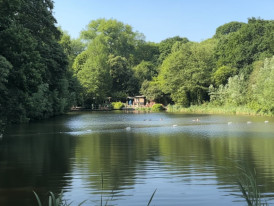
Swimmers at Hampstead Heath mixed pond
Alexandra Palace Slopes at Golden Hour
Alexandra Palace in north London has slopes perfect for picnics. I come for sunset when the light turns everything gold. People bring wine, cheese, speakers playing music quietly. The vibe is relaxed and communal.
The views rival anything you'd see from Primrose Hill with maybe a third of the crowds. Winter is quieter and just as beautiful when frost covers the grass.
Plus, if you're an adventurous person visiting London, you can check out outdoor activities like the Go Ape treetop adventure, the skatepark, and boating on the lake.

Alexandra Palace Slopes at Golden Hour
Little Venice Canal Walks in Early Morning
Little Venice sits where the Grand Union and Regent's canals meet in west London. Early mornings are most peaceful. I walk from Little Venice through Regent's Park to Camden when I need to reset, usually starting around 7 AM. This west London canal route offers a completely different energy from the grittier east London neighborhoods.
Narrow boats float quietly, ducks paddle between them, the towpath is almost empty. The walk takes about an hour. Canal-side cafés open for breakfast, houseboats have window boxes full of flowers.
Takeaway: London's nature isn't just Hyde Park and Kew Gardens. These spots give you sweeping views, wild swimming, and quiet canals if you arrive early enough.
Beyond the London Checklist
Discover the city guidebooks don’t cover with a local by your side.

Brick Lane Curry Restaurants
What Are the Overrated
Not every place that gets called a hidden gem deserves the title. Some are just tourist traps with better marketing, and locals learned to avoid them years ago.
Brick Lane's "Curry Capital" Reputation
Brick Lane gets sold as London's curry capital, but that's 30 years out of date. The restaurants mostly cater to drunk students and tourists. Locals know better.
If you want actual excellent curry, go to Tooting High Street for Sri Lankan, Tamil, and Pakistani food. Try Southall or Wembley for proper Punjabi cooking. Visit Whitechapel for Bangladeshi spots that haven't been compromised. The quality difference is obvious.
Brick Lane still has value: Beigel Bake for late-night salt beef bagels is a genuine institution. The vintage market on Sundays has good finds. The street art is worth seeing. But for curry? There are better options.
Borough Market at Peak Times
Borough Market has incredible vendors. But weekends between 11 AM and 3 PM turn into gridlock where you can barely move, you're queuing 20 minutes for a sandwich.
The smart move: visit Borough Market on weekday mornings when it's quiet. Or skip it entirely and go to Maltby Street Market instead. Smaller, less touristy, excellent vendors. Broadway Market in Hackney on Saturdays is another good alternative.

Busy Borough Market at midday
The Churchill Arms Pub
The Churchill Arms in Notting Hill is photogenic. Exterior covered in flowers, gets shared on social media constantly. I went once because a visiting friend insisted. It was rammed with tourists taking selfies, standard beer selection, felt more like a photo opportunity than a proper pub.
For an actual good London pub experience, try The Wenlock Arms in Hoxton. I go regularly: excellent cask ales, friendly regulars, a beer garden, zero interest in Instagram. The Harp near Trafalgar Square is another solid choice. The French House in Soho pours wine and serves character.
Camden Market's Mainstream Zones
Camden Market has eaten itself. Parts, especially around Camden Lock and the high street, have become corporate mall versions of what used to be alternative. Chain restaurants, tourist tat, overpriced "vintage."
That said, pockets still work. Stables Market has decent food stalls. The canal walk is pleasant. And the neighborhood around Camden has excellent pubs and independent restaurants if you walk five minutes away.
Takeaway: Not every famous spot deserves its reputation. Brick Lane's curry scene is overrated compared to Tooting, Southall, or Wembley. Borough Market at peak times is chaos you can avoid by going to Maltby Street Market or visiting weekday mornings. The Churchill Arms is a selfie stop, not a real pub experience. Camden Market has become too mainstream in most sections.
Imagine Having a Friend in Every City
Our locals share their city with you the way they live it: flexible, real, and unscripted.
Shoppers at Columbia Road flower market
How Do You Navigate London's Hidden Corners?
Knowing where to go only matters if you also know when to go, how to get there, and what to expect when you arrive. Here's the practical side of finding London's real gems.
Timing Matters More Than You Think
London operates on rhythms that reward early birds and night owls. Markets like Broadway, Maltby Street, and Ridley Road are best between 9 AM and Noon. Museums like Sir John Soane's or Dulwich Picture Gallery work perfectly on weekday mornings. Parks hit magic hour right before sunset, canal walks shine at dawn.
Late nights have their own logic. Beigel Bake on Brick Lane is an institution at 3 AM. The Night Tube runs on weekends, making cross-city trips after Midnight surprisingly easy.
Transport Is Simpler Than It Looks
Get an Oyster card or use contactless payment. Both cap your daily spending automatically. The Tube is fastest for long distances, but buses show you the city. In central London, late Friday slots at the British Museum or the Royal Academy feel calmer than weekends.
Walking matters. I walk from Shoreditch to Hackney in east London, from Peckham to Dulwich, from King's Cross along the canal to Camden. You notice more on foot: the way neighborhoods change within three blocks, the small shops you'd never find otherwise.
Beyond the London Checklist
Discover the city guidebooks don’t cover with a local by your side.
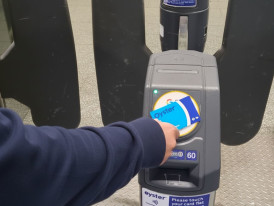
Contactless card on Tube gate
Step-Free Access Requires Planning
Not all Tube stations have lifts. Check the Transport for London website before you travel. Buses are more reliable for accessibility since they all have ramps.
Many heritage venues like Wilton's Music Hall and Sir John Soane's Museum have stairs and narrow passages. Hampstead Heath has uneven paths. Markets like Ridley Road and Queens Market are mostly at curb level. Always check ahead if access is a concern.

London Underground accessibility
Safety and Street Smarts
London is generally safe, but late nights in busy areas require usual city awareness. I walk home through Dalston regularly after poetry nights. It's lively, which means it's safe in the sense that people are around. Stick to main streets late at night, keep an eye on your belongings, trust your instincts.
Residential streets in neighborhoods like Peckham, Hackney, and Tooting are quiet after dark because people live there. Walk with purpose, respect the people who live here.
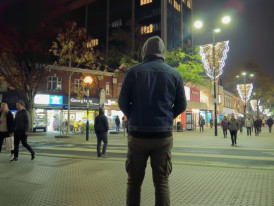
High Street at night
Weather Changes Everything
London weather is unpredictable. Parks and canal walks are perfect when it's sunny, but rain sends everyone indoors. That's when you pivot to museums, galleries, covered markets, pubs with fireplaces, or cafés.
Summer brings long daylight hours and outdoor everything: park picnics, rooftop drinks, riverside pubs. Winter is darker and colder but also emptier at popular spots. Some of my favorite London days happen in January when tourist numbers drop.
Takeaway: Hidden gems require strategy. Go early to markets, late to museums, and at golden hour to parks. Walk when you can. Check step-free access if needed. Have backup plans for when weather changes.
Before You Go, Talk to Someone Who Knows
A local video call helps you plan the trip that’s right for you.
Frequently Asked Questions About London's Hidden Gems
1) Is Borough Market Really a Hidden Gem?
No, Borough Market is famous and busy, especially weekends. But visit weekday mornings before 10 AM for a different experience: vendors setting up, fewer crowds, actual time to talk. That version works. For a true alternative, try Maltby Street Market on Saturdays.
2) Where Do Locals Actually Get Bagels?
Brick Lane has Beigel Bake, which is legitimate for late-night salt beef bagels. But locals also go to Carmelli Bakery in Golders Green for excellent bagels without tourist crowds. That's where I go on Sunday mornings. Or Rinkoff's in Whitechapel for creative takes like cronuts.
3) Which Art Galleries Feel Quieter Than the Big Museums?
Sir John Soane's Museum in Holborn, Dulwich Picture Gallery in south London, and the Wallace Collection near Oxford Street all offer world-class art without overwhelming crowds. The Barbican also hosts excellent exhibitions with room to breathe. The Royal Academy near Piccadilly has blockbuster shows that draw crowds, but their smaller side galleries are often overlooked.
Even the British Museum has quiet moments if you know when to go: late Friday evenings or weekday mornings right when they open. For unusual museums, the Horniman in south London offers anthropology collections and musical instruments most visitors never discover.
4) What's the Best Afternoon Tea Experience That Isn't Touristy?
Afternoon tea at Claridge's or The Wolseley is beautiful but expensive and often fully booked months ahead. For something more accessible, try the V&A Café at the Victoria and Albert Museum for afternoon tea in a stunning room with far less pressure. Or skip formal afternoon tea entirely and visit a good bakery like E5 Bakehouse or Pophams for excellent pastries and coffee.
5) Are There Any Secret Gardens in Central London?
The term "secret gardens" gets overused for marketing, but quieter green spaces exist. St. Dunstan in the East is a ruined church turned garden near Monument. The roof gardens at 120 Fenchurch Street are free but require booking. Phoenix Garden in Covent Garden is tiny but peaceful when you need five minutes away from the West End chaos.
For larger green spaces, try Burgess Park in south London or Abney Park Cemetery in Stoke Newington, which is both cemetery and nature reserve. If you want botanical collections, Kew Gardens is famous for good reason, though the crowds can be intense. The Chelsea Physic Garden offers a quieter alternative.
6) How Do I Find Street Art Without a Guided Tour?
East London, particularly Shoreditch, Brick Lane, and around Hanbury Street, has constantly changing street art. Just walk and look. The art changes weekly, so any map or guide tour is already outdated.
Leake Street Tunnel near Waterloo is legal graffiti space that changes constantly. Notting Hill has some Banksy pieces if you search for their locations online first. You don't need a guided tour, just pay attention to walls, shutters, and side streets.
7) Is Little Venice Worth Visiting?
Little Venice works best as part of a canal walk rather than a destination itself. I start there early in the morning around 7 AM, walk the towpath through Regent's Park to Camden, and by the time I reach Camden the whole city is waking up. It's peaceful if you go before 10 AM.
But it's not a hidden gem, just a lovely spot that timing makes better. If you're expecting something secret or undiscovered, you'll be disappointed. If you're looking for a pleasant morning walk in west London that connects interesting neighborhoods, it delivers.
8) What About Portobello Road and Notting Hill?
Portobello Road Market in Notting Hill is famous, especially on Saturdays when antiques dealers set up and tourists flood the area looking for colourful houses to photograph. It's not a hidden gem by any definition. The market can be interesting if you arrive early on Saturday mornings before 9 AM, but by 11 AM it's shoulder-to-shoulder crowds.
If you're exploring Notting Hill anyway, the side streets away from Portobello Road are prettier and quieter. Or visit on weekday afternoons when the tourist crowds thin. But be honest about what this is: a famous market in a famous neighborhood.
9) What Can I Do in London at Night Besides Pubs?
London's night scene includes late-night museums where some stay open until 10 PM on Fridays, 24-hour bagel shops like Beigel Bake, bowling at Rowans in Finsbury Park, and live music at venues like Wilton's Music Hall or smaller spots in Dalston.
I've also done late dinners in Chinatown, wandered Green Lanes for Turkish grills that stay open past 11 PM, and taken the Night Tube on weekends. Walk along the River Thames at night for a different perspective on the city, with the City of London skyline lit up and London Bridge offering views both ways. If you're exploring things to do at night in London beyond standard pub culture, you'll find the city has more options than most realize.
10) Where's the Best Food Market for Locals?
Ridley Road Market in Dalston, Queens Market in Upton Park, and Walthamstow Market all serve local communities rather than tourists. Walthamstow Market is one of Europe's longest street markets, full of fabric stalls, produce vendors, and cheap household goods.
Prices at these markets are dramatically lower than central London, produce is fresher, and you'll find ingredients from West African, Caribbean, South Asian, and Turkish cuisines that aren't available in regular supermarkets.
11) Which London Neighborhoods Should I Explore Beyond Central London?
Peckham has West African restaurants, modern wine bars, and Peckham Rye Park for weekend picnics. Hackney offers Broadway Market on Saturdays, London Fields for summer afternoons, and excellent Turkish food on Ridley Road. Tooting has the best South Asian food in the city concentrated along one high street.
Dalston mixes Turkish ocakbaşı grills with creative cocktail bars and late-night energy. These neighborhoods show you London's actual diversity better than staying in zones one and two ever will. For more depth, check our guide to the best neighborhoods in London.
12) Do I Need to Book Churchill War Rooms in Advance?
Yes, Churchill War Rooms are popular and often sell out, especially in summer. But they're not a hidden gem, they're a major museum attraction. The same goes for Westminster Abbey, which requires advance booking and draws massive crowds. If you want lesser-known history museums, try the Museum of London Docklands or the Horniman Museum in Forest Hill.
13) Are Kew Gardens and Kew Palace Hidden Gems?
Kew Gardens is stunning but very famous, especially in spring when the flowers bloom. Kew Palace sits inside the gardens and offers royal history in a smaller, more intimate setting than Buckingham Palace crowds. Neither is truly hidden, but they're worth visiting if you have time.
For quieter gardens, try Holland Park near Notting Hill which has Japanese gardens and peacocks, or the Chelsea Physic Garden for specialized plant collections. If you're exploring west London, these make better alternatives.
14) How Do I Experience Harry Potter Locations Without the Big Ben and London Eye Tourist Trail?
Platform 9¾ at King's Cross Station has a dedicated photo spot that's always busy. Leadenhall Market doubles as Diagon Alley exterior shots and is worth seeing for the Victorian architecture. Millennium Bridge appears in Half-Blood Prince.
15) What's a Locals' Guide Approach to Visiting London?
A local approach means eating where immigrants eat, not where restaurants perform ethnicity for tourists. It means shopping at markets that serve neighborhoods rather than Instagram, visiting parks that don't appear in guidebooks, and timing your visits to avoid peak crowds.
16) What Are Some Great Ideas for a Different Side of London?
Take the Overground around the entire circle and get off at random stops. Walk the canals from Little Venice to Camden. Eat your way through Tooting Market. Spend Saturday morning at Ridley Road buying produce, then bus to Dulwich Picture Gallery, then end in Peckham for West African food.
Swim in Hampstead Heath ponds if you're brave enough. Watch sunset from Alexandra Palace slopes. Skip Oxford Street and explore the side streets off the beaten path where locals actually shop. The different side of London isn't hidden. It's just happening in places visitors don't usually look, far from South Kensington museums and Sloane Square boutiques.

Street art in the backstreets of Shoreditch
Final Thoughts: What Hidden Gems in London Truly Mean
I'm suspicious of the phrase "hidden gems in London" because it suggests there's a secret version of the city you can unlock with the right list. The places I've shared here aren't hidden in the sense that locals are guarding them jealously. They're just the spots we use because they make sense in our actual lives. These are my favorite places in London, the ones that never get old.
The difference between a tourist attraction and a real local spot isn't always obvious from the outside. Borough Market and Maltby Street Market both sell excellent food. The difference is timing, crowd size, and whether you're there because you need good cheese and sourdough or because a guidebook told you to tick it off.
What I hope you take from this isn't just a list of places to visit and 'must-sees' to really explore London. I hope you develop a sense for what makes a place feel authentic versus what makes it feel performed. Go early, go late, go on random weekdays. Talk to people who work at markets and cafés. Wander neighborhoods without a plan.
London is too big and too layered for any one person to know completely. But these corners, these routines, these markets and parks and wine bars, they're what make it feel like home to me.
I hope sharing them helps you find your own version of that feeling, even if you're only here for a short trip to London and trying to see as much as possible before heading back to explore more of England or look for other United Kingdom experiences.
More on London
Ready to Plan Your Perfect Day in London?
Start your experienceExperiences Created by Locals, Just for You
See the city through the eyes of the people who call it home.
Explore With UsWish You Had a Local Friend in London?
One who knows the city inside out and could plan a private day just for you? Our local hosts do exactly that: no scripts, no tourist traps, just the side of the city most people miss.









